Quick Navigation:
- Understanding the Risks
- Steps to Permanently Delete Digital Financial Documents
- Best Practices for Regular Financial Document Management
- Conclusion
In today's digital age, the need to safeguard sensitive information, especially financial documents, cannot be overstated. With identity theft, fraud, and cybercrime on the rise, ensuring that financial documents are permanently deleted is crucial. This article dives deep into the importance of securely deleting financial documents, common mistakes people make, and effective methods to ensure that once deleted, these files cannot be recovered.
Financial documents contain sensitive information such as bank account details, tax records, credit card information, and personal identification data. If these documents fall into the wrong hands, they can lead to severe consequences, including identity theft, unauthorized transactions, and significant financial loss. Therefore, permanently deleting financial documents is not just a matter of good practice but a critical step in protecting your financial security.

Understanding the Risks
The risks of not properly deleting financial documents are significant. Financial documents that are merely deleted through conventional means (like moving them to the Recycle Bin or Trash) are not permanently erased. These files can be easily recovered using data recovery tools, putting your sensitive information at risk. In many cases, hackers and cybercriminals specifically target discarded or improperly deleted files to extract valuable information.
For instance, a discarded hard drive from a financial institution could still contain recoverable data, leading to a potential data breach. In 2017, a UK-based financial firm was fined heavily for failing to securely erase data from recycled devices, resulting in a data breach that compromised the personal information of thousands of clients. This incident highlights the importance of ensuring that financial documents are permanently deleted to prevent unauthorized access and misuse.
Common Mistakes in Deleting Financial Documents:
- Assuming Deleting to the Recycle Bin or Trash is Sufficient: Moving a file to the Recycle Bin or Trash only removes the reference to the file in the file system. The space the file occupied becomes available for new data, but the original file remains intact until it is overwritten, making it recoverable with specialized software.
- Using Basic File Deletion Commands: Commands like "Shift + Delete" on Windows or "Command + Delete" on macOS bypass the Recycle Bin or Trash but do not ensure permanent erasure. The data remains on the storage device until overwritten, which may take a long time if there is ample free space.
- Overlooking Copies of Financial Documents in Other Locations: Users may forget to delete copies of financial documents stored in cloud services, external drives, or backup systems. Even if the original file on the local device is securely erased, failing to address these additional copies leaves sensitive information vulnerable.
Steps to Permanently Delete Digital Financial Documents
1. Identify the Documents to Delete
The first step in securely deleting digital financial documents is to identify which files need to be permanently erased. These may include:
- Tax Returns: Once you've kept these for the required period, typically seven years, you should permanently delete them.
- Bank Statements: Retain only the statements needed for ongoing financial management or tax purposes, and delete the rest.
- Credit Card Records: Delete these after you’ve reconciled your transactions and no longer need them for your records.
- Investment Records: Keep digital copies only as long as necessary and delete older files that are no longer required.
2. Encrypt Sensitive Documents
Before deleting any financial documents, consider encrypting them. Encryption adds a layer of security by converting your files into unreadable code, which can only be decrypted with the correct key or password. Even if the files are recovered, they will be inaccessible without the decryption key.
- VeraCrypt: An open-source encryption tool that can create encrypted containers for storing sensitive files.
- BitLocker: A built-in Windows tool that encrypts entire drives, offering strong protection against unauthorized access.
- FileVault: A macOS encryption tool that secures your entire hard drive, making sure that even if files are recovered, they remain encrypted.
3. Using Built-in OS Tools
Most operating systems have built-in tools that allow for more secure file deletion. On Windows, users can utilize the "Secure Delete" option available in some versions of the operating system. This feature overwrites the data multiple times, making it much harder to recover. On macOS, the "Secure Empty Trash" option is available, which performs a similar function.
To use these tools:
- Windows: Right-click on the file and select "Delete." Then, use a third-party tool like Cipher.exe (available in Command Prompt) to securely erase the free space where the file was stored.
- macOS: After moving files to the Trash, right-click on the Trash icon and select "Secure Empty Trash" to overwrite the deleted files.
4. Use File Shredding Software
To ensure that deleted files cannot be recovered, you should use file shredding software. Unlike regular deletion methods, file shredders overwrite the data multiple times, making it virtually impossible to retrieve.
- DoYourData Super Eraser: One of the best data erasure programs to help in permanently erasing data from PC, Mac and external storage devices.
- CCleaner: A widely-used tool that includes a file shredder to permanently delete files by overwriting them.
- Eraser: An open-source tool that provides robust file shredding capabilities, allowing you to securely erase files from your hard drive.
- Secure Erase: This tool operates at the hardware level, ensuring that files are completely wiped from your storage device.
For example, you can use DoYourData Super Eraser to securely and permanently shred your financial documents with these steps:
Step 1. Download and install DoYourData Super Eraser on your computer. Then open it.
Step 2. Choose mode - Erase Files/Folders, click add to select the financial documents you want to erase. Then click on Erase Now button.
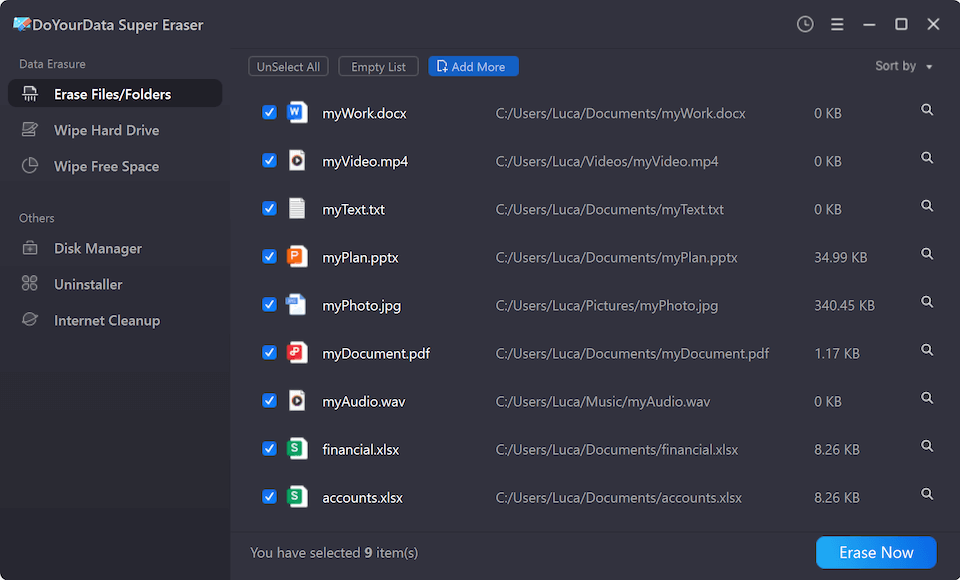
Step 3. It will securely and permanently erase all the selected financial documents.
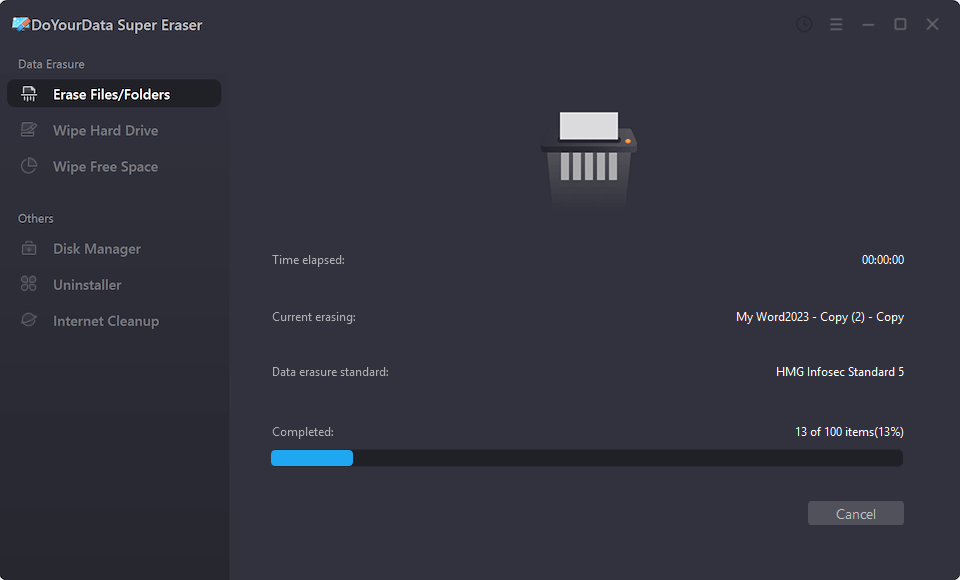
5. Wipe Your Hard Drive
If you need to dispose of a device that contains financial documents, simply deleting files is not enough. You should perform a complete hard drive wipe to ensure that all data is irretrievably erased.
Step 1. Open DoYourData Super Eraser and choose Wipe Hard Drive mode.
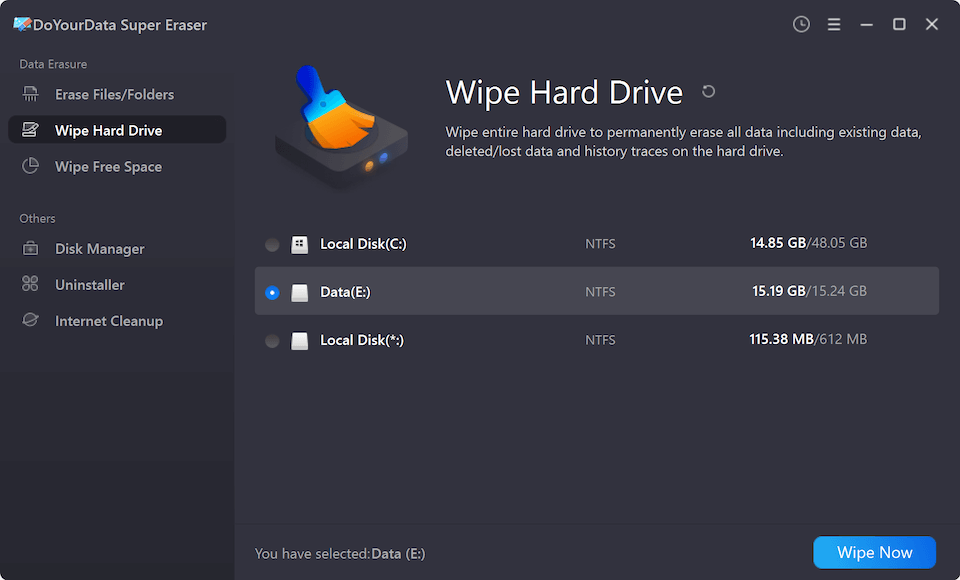
Step 2. Select the hard drive where you store your financial documents, then click on Wipe Now button.
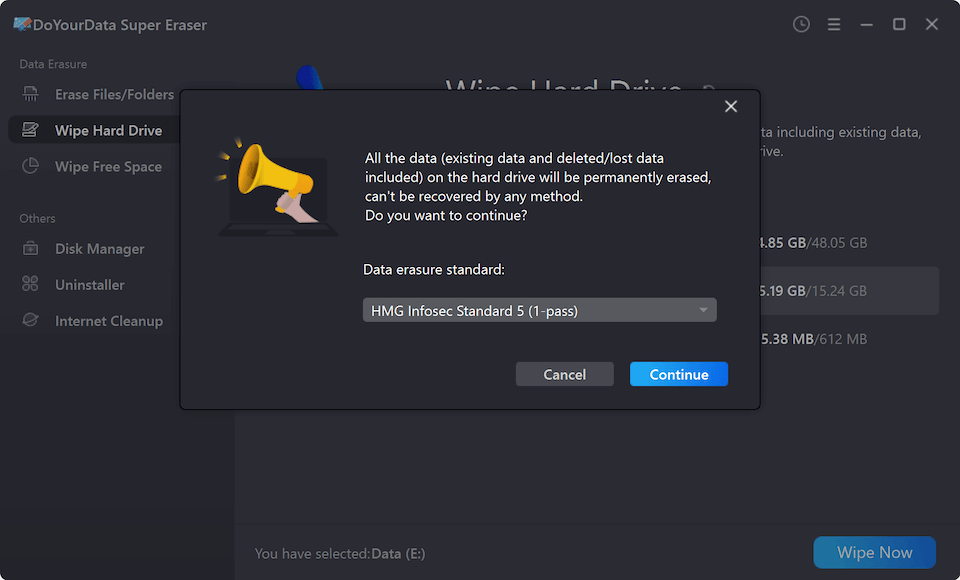
Step 3. Select a data erasure standard and click on Continue button.
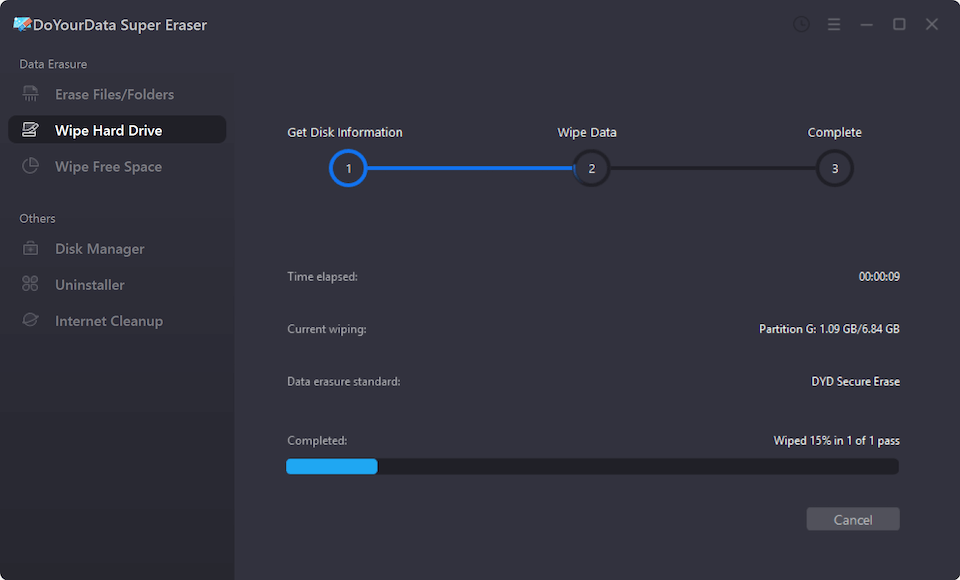
Step 4. Format and wipe the drive, permanently erase all data from the drive.
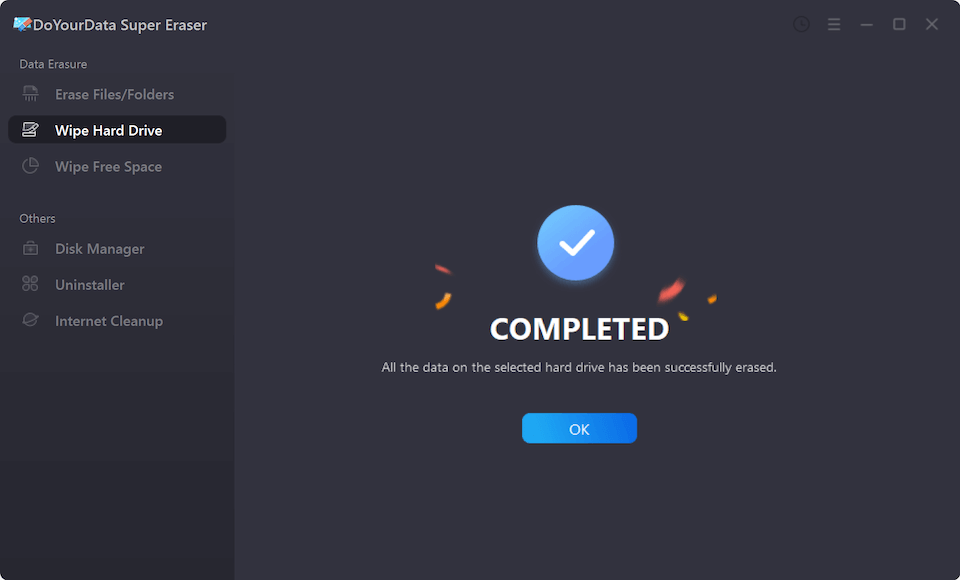
Other disk wipe software:
- DBAN (Darik's Boot and Nuke): A free tool that completely wipes your hard drive, making it impossible to recover any data.
- Blancco Drive Eraser: A commercial-grade tool used by businesses to securely erase all data from hard drives and other storage devices.
- Active@ KillDisk: A powerful disk-wiping tool that supports multiple wiping standards and works with various storage devices.
6. Delete Cloud-Based Files Securely
Many people store their financial documents in cloud storage services such as Google Drive, Dropbox, or OneDrive. When you delete files from the cloud, make sure you also permanently delete them from the service's trash or recycle bin to prevent recovery.
- Google Drive: After deleting files, ensure you empty the trash to permanently erase them.
- Dropbox: Files deleted from Dropbox are moved to a recycle bin; make sure you permanently delete them from there.
- OneDrive: After deleting files from OneDrive, empty the recycle bin to ensure they are not recoverable.
7. Securely Dispose of Devices
When disposing of a device that has stored digital financial documents, take additional precautions to ensure that data cannot be recovered.
- Factory Reset: Perform a factory reset on the device to erase all data. This is particularly important for smartphones, tablets, and other portable devices.
- Physical Destruction: For devices that are being permanently retired, consider physically destroying the storage media. Drilling holes in a hard drive or using a hammer to smash a USB stick ensures that data cannot be recovered.
Case Study: Successful Permanent Deletion
Consider the case of a financial consultancy firm that needed to dispose of outdated client records securely. The firm implemented a comprehensive data destruction policy that included the use of encryption, multiple pass wiping, and physical destruction of storage media. By using tools like VeraCrypt for encryption and DoYourData Super Eraser for data wiping, the firm ensured that all sensitive financial documents were rendered unrecoverable before disposing of the storage devices. This proactive approach not only protected the firm's clients but also helped maintain compliance with industry regulations.
The firm's successful implementation of these practices highlights the importance of using a combination of techniques to ensure the secure deletion of financial documents. By doing so, they mitigated the risks of data breaches and safeguarded their reputation in the industry.
Best Practices for Regular Financial Document Management
In addition to securely deleting financial documents, it's essential to manage them effectively throughout their lifecycle. Here are some best practices:
Developing a Routine:
Establish a regular schedule for reviewing and deleting outdated financial documents. This routine should include:
- Regular Audits: Periodically audit your financial documents to identify those that are no longer needed.
- Categorization: Organize documents into categories based on their importance and retention period.
- Scheduled Deletion: Set up a calendar reminder to review and securely delete documents at the end of their retention period.
Backup Considerations:
While it's essential to delete unnecessary financial documents, it's equally important to ensure that you have secure backups of any documents you may need in the future. However, these backups must also be managed carefully:
- Encrypt Backups: Ensure that all backups are encrypted to protect them from unauthorized access.
- Secure Deletion of Backups: When a backup is no longer needed, use the same secure deletion methods to ensure that the data is permanently erased.
By following these best practices, you can maintain a secure and organized financial document management system that minimizes the risk of data breaches.
Conclusion
Permanently deleting financial documents is an essential practice for safeguarding sensitive information and protecting yourself or your organization from the risks of data breaches, identity theft, and legal liabilities. By understanding the limitations of standard deletion methods and implementing more secure techniques, you can ensure that your financial documents are permanently erased and unrecoverable.
Key takeaways include the importance of using encryption, specialized data wiping software, and advanced techniques like multiple pass wiping to enhance security. Additionally, physical destruction of storage media should be considered in cases where the utmost security is required. Finally, complying to best practices for financial document management and ensuring compliance with legal and regulatory requirements will help maintain a secure and organized system.
Take action today by evaluating your current document deletion practices, implementing the recommended methods, and regularly auditing your processes to ensure ongoing security. By doing so, you'll protect your financial information and contribute to a safer digital environment.

DoYourData Super Eraser
DoYourData Super Eraser, the award-winning data erasure software, offers certified data erasure standards including U.S. Army AR380-19, DoD 5220.22-M ECE to help you securely and permanently erase data from PC, Mac, HDD, SSD, USB drive, memory card or other device, make data be lost forever, unrecoverable!